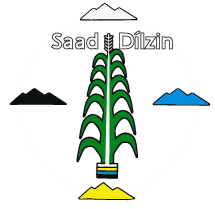Glossing and Morphology
Navajo verbs have notoriously complex morphology. We gloss the component morphemes (meaningful parts) in their order of appearance. We include the basic meaning of the stem (=inflected root) with its mode, the arguments (indicated by integers 1, 2, 3, and 4 for first, second, third, and fourth person), the plural prefix (da-) if it is present, any incorporated postpositions, and any derivational prefixes that affect the valence or meaning of the verb significantly. We do not gloss every morpheme posited in the analyses of, for example Sapir & Hoijer (1967), Faltz (1998), or Young & Morgan (1987).
Navajo sentences are provided in the conventional orthography. Navajo verbs are polysynthetic, meaning that it is difficult to divide them into their component morphemes without considerable abstraction. We do provide glosses for significant morphemes, but we do not attempt to indicate morpheme boundaries within the conventional orthography. Those interested in morphological analysis are directed to Kari (1973) and Faltz (1998), in addition to Young (2000), Young & Morgan (1987), and Young, Morgan, & Midgette (1992).
In our verb glosses, hyphens indicate boundaries between morpheme glosses. Periods are used to gloss a single Navajo morpheme that requires more than one English word or abbreviation to gloss. Subject, object, indirect object, and object of an incorporated postposition are indicated by morpheme order: Indirect object or object of a postposition appear first, followed by a direct object, with the subject appearing last.
Example (i) is an intransitive verb. The numeral 4 indicates that the subject is fourth person. I indicates that the mode is imperfective. The verb stem is the final syllable (-taał). The initial syllable (da-) indicates that the verb is plural.
Example (ii) is a transitive verb. The object prefix precedes the subject prefix, thus the gloss indicates that the subject is first person and the direct object is third person. The mode is perfective, as indicated by P.
Example (iii) has three arguments. The indirect object precedes the direct object, which precedes subject. This verb is classificatory: SSO indicates that part of the verb’s meaning is that a slender, stiff object is being handled. For this verb, the SSO corresponds to the direct object. The mode of the verb is perfective.
Example (iv) consists of a transitive verb that has an incorporated postposition, which itself has an argument. The order of prefixes is object of postposition (3), followed by a postposition (from), followed by direct object (3), followed by Subject (1), followed by the verb stem (take.OC.P). P indicates that the verb is in the perfective mode. OC indicates that the direct object is handled in an open container.
There are no verbs in Navajo that have both an indirect object and the object of an incorporated postposition. Nor are there any verbs with more than three arguments.
| dahojitaał |
| pl-4-sing.I |
| They are singing |
| bidánééł’į́į́’ |
| 3-1-look.at.P |
| I looked at it |
| Shiidiitsi |
| 1-3-3-point.SSO.P |
| S/he pointed it at me |
| Bits’áníką́ |
| 3-from-3-1-take.OC.P |
| I took it (in an open container) away from it |
Glosses used
Glosses for Arguments
| gloss | meaning | English | Navajo morpheme | |
|---|---|---|---|---|
| 1 | first person | (speaker) | I | sh |
| 2 | second person | (spoken to) | you | ni |
| 3 | third person | (spoken about) | he/ she/ it | ∅ (yi/bi) |
| 4 | fourth person | (spoken about) | one | ji (ho) |
Glosses for Modes
- CI
- Continuative Imperfective
- F
- Future Mode
- I
- Imperfective Mode
- N
- Neuter Mode
- NI
- Neuter Imperfective Mode
- NP
- Neuter Perfective Mode
- P
- Perfective Mode
- Prog
- Progressive Mode
- R
- Iterative Mode
- SPN
- Si-Perfective Neuter Mode
- U
- Usitative Mode
Glosses for Classificatory Verbs
- AnO
- Animate Object
- FFO
- Flat Flexible Object
- LPB
- Load, Pack, Burden
- LUG
- Anything carried on one’s back
- MM
- Mushy Matter
- NCM
- Non-Compact Matter
- OC
- Open Container
- PlO1
- Plural Objects1 (several large objects)
- PlO2
- Plural Objects2 (profusion of small objects)
- SFO
- Slender Flexible Object
- SRO
- Solid Roundish Object
- SSO
- Slender Stiff Object
- STREAM
- Anything moved by streaming or pouring
Other glosses
- dpl
- duo-plural (two or more)
- du
- dual (two)
- NEG
- negative
- pl
- plural (three or more)
- Q
- question particle or enclitic
- TOP
- topic




